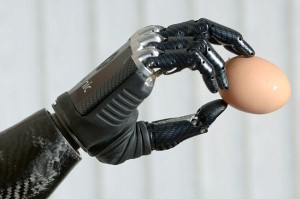The Rise of the Human Cyborg?
It’s happening! The American food and drug authority has approved the use of a robotic arm for patients who have lost the use of their arms. With this and the progress made in the field of prosthetics in general could we be seeing the rise of the Human Cyborg?
No longer does a prosthetic arm mean a having a hook at the end of some ill fitted piece of plastic. The Deka Arm’s revolutionary design means its fingers can move much more realistically so it is easier for amputees to perform everyday tasks. The arm, the first of its kind to be approved by medical authories in the US, also has a much greater range of movement and replaces the old technology used in existing devices, many of which are still based on designs more than 100 years old. The arm uses electrodes to detect miniscule muscle movements that the wearer makes so that they can learn to make 10 different movements.
While there have been vast improvements within the field of prosthetics, much of the work has focused on the legs as opposed to arms and hands. This is because of the immense engineering challenge that human hands cause. $40 million (£24 million) of research from the US Defence Advanced Research Projects Agency was invested with the aim of improving the range of robot limbs out there for those who had lost upper limbs.
Justin Sanchez, spokesman for the arm’s creators told Reuters, “It was designed to produce near-natural upper extremity control to injured people who have suffered amputations…This prosthetic limb system can pick up objects as delicate as a grape, as well being able to handle very rugged tools like a hand drill”
Progress within the field of artificial limbs can also be credited to the tireless work of Dr Herr. After losing both of his legs in an accident he went on to design artificial limbs that use a synthetic skin for greater comfort to the wearer. His limbs have moved on from the traditional wood, rubber or plastics and become truly bionic. Talking about how he felt after his accident he said, “I didn’t view my body as broken. I saw it as a call to arms to eliminate my own disability and those of others.”
With these progressions in technology we see the advent of a new era. The era of the bionic man. Hopefully, with more funding and the tireless work of people like Dr. Herr, there will be a time when no one in the world has to live a lesser life due to a disability.


